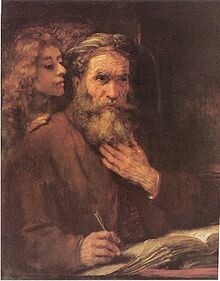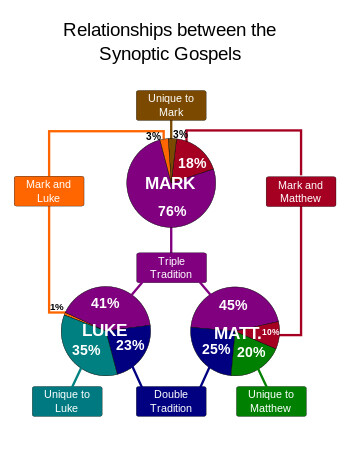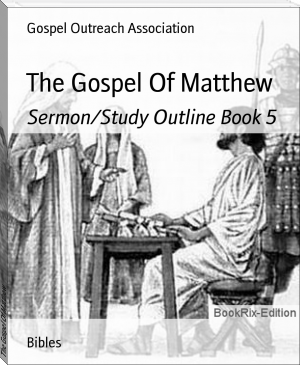The Gospel According to Matthew THE REAL TRUTH by JACOB GEORGE (best classic books .txt) 📖

- Author: JACOB GEORGE
Book online «The Gospel According to Matthew THE REAL TRUTH by JACOB GEORGE (best classic books .txt) 📖». Author JACOB GEORGE
The Gospel According to Matthew (Matthew)
My intension of writing this book is only to Praise GOD and give thanks to Him, who is Almight and all powerful. I personaly have recived many bessings by Praising GOD. I spoke to many persons who have been blessed when they Praised GOD. Our God will do great things for You.
Our Web : http://fm-church.blogspot.com
For Copies Please contact :
G Jacob George, S/O Rev G Dayanand
# 1-9-69/A/1, Ramnagar, Hyderabad,
Telangana(AP), India – 500020.
Mobile # 91-09985117937 , 91-09177389232
E Mail ID – gjacobgeorge77@gmail.com, gjacobgeorge@rediffmail.com.
Index
S.No Name Page No
Introduction 3
Meaning 5
Historical background 6-16
Theme 17-20
Focus (Subject expanding) 21-25
Application to present day context 26-30
Reflection 31
Bibliography 34-38
Introduction
In the second century a.d., the Gospel of Matthew was placed at the very beginning of the New Testament. It was believed to be the first Gospel written, though we now know that the Gospel of Mark dates earlier. Because it is the Gospel most intensely concerned with issues related to Judaism, it provides an appropriate transition from the Old Testament to the New Testament in the Christian Bible. Matthew became the most important of all Gospel texts for first- and second-century Christians because it contains all the elements important to the early church: the story about Jesus’s miraculous conception; an explanation of the importance of liturgy, law, discipleship, and teaching; and an account of Jesus’s life and death. The Gospel of Matthew has long been considered the most important of the four Gospels.
Though second-century church tradition holds that the author of the Gospel is Matthew, a former tax collector and one of Jesus’s Twelve Apostles, also known as Levi, scholars today maintain that we have no direct evidence of Matthew’s authorship. Because the Gospel of Matthew relies heavily on the earlier Gospel of Mark, as well as late first-century oral tradition for its description of events in Christ’s life, it is unlikely that the author of the Gospel of Matthew was an eyewitness to the life of Christ. Instead, the author was probably a Jewish member of a learned community in which study and teaching were passionate forms of piety, and the Gospel was probably written between 80 and 90 a.d.
Matthew is arranged in seven parts. An introductory segment gives the story of Jesus’s miraculous birth and the origin of his ministry, and a conclusion gives the story of the Last Supper, Jesus’s trial and crucifixion, and the resurrection. In the middle are five structurally parallel sections. In each section, a narrative segment—interrupted occasionally by dialogue and brief homilies—tells of Jesus’s miracles and actions. Closing each section, Jesus preaches a long sermon that responds to the lessons learned in the narrative section. The Sermon on the Mount, which introduces the basic elements of the Christian message, follows Jesus’s first venture into ministry (5:1–7:29). The Mission Sermon, which empowers Jesus’s apostles, follows Jesus’s recognition that more teachers and preachers are necessary (10:1–42).
Introduction
The mysterious Sermon in Parables responds to Jesus’s frustration with the fact that many people do not understand or accept his message (13:1–52). The Sermon on the Church responds to the need to establish a lasting fraternity of Christians (18:1–35). Finally, the Eschatological Sermon, which addresses the end of the world, responds to the developing certainty that Jesus will be crucified (23:1–25:46)
Meaning
The Gospel According to Matthew
Greek: κατὰ Ματθαῖον εὐαγγέλιον, kata Matthaion euangelion, τὸ εὐαγγέλιον κατὰ Ματθαῖον, to euangelion kata Matthaion
Gospel of Matthew or simply Matthew is one of the four canonical gospels, one of the three synoptic gospels, and the first book of the New Testament. The narrative tells how the Messiah, Jesus, rejected by Israel, finally sends the disciples to preach his Gospel to the whole world.
Most scholars believe the Gospel of Matthew was composed between 80 and 90; a pre-70 date remains a minority view. The anonymous author was probably a highly educated Jew, intimately familiar with the technical aspects of Jewish law, and the disciple Matthew was probably honored within his circle. According to the majority of modern scholars, the author drew on three main sources to compose his gospel: the Gospel of Mark; the hypothetical collection of sayings known as the Q source; and material unique to his own community, called "Special Matthew", or the M source.
Matthew intends to prove to the Jews that Jesus Christ is the promised Messiah. More than any other gospel, Matthew quotes the Old Testament to show how Jesus fulfilled the words of the Jewish prophets. Matthew describes in detail the lineage of Jesus from David, and uses many forms of speech that Jews would have been comfortable with. Matthew’s love and concern for his people is apparent through his meticulous approach to telling the gospel story.
Matthew discusses the lineage, birth, and early life of Christ in the first two chapters. From there, the book discusses the ministry of Jesus. The descriptions of Christ’s teachings are arranged around “discourses” such as the Sermon on the Mount in chapters 5 through 7. Chapter 10 involves the mission and purpose of the disciples; chapter 13 is a collection of parables; chapter 18 discusses the church; chapter 23 begins a discourse about hypocrisy and the future. Chapters 21 through 27 discuss the arrest, torture, and execution of Jesus. The final chapter describes the Resurrection and the Great Commission.
Historical background
Most scholars believe the Gospel of Matthew was composed between 80 and 90;[2] a pre-70 date remains a minority view. The anonymous author was probably a highly educated Jew, intimately familiar with the technical aspects of Jewish law, and the disciple Matthew was probably honored within his circle. According to the majority of modern scholars, the author drew on three main sources to compose his gospel: the Gospel of Mark; the hypothetical collection of sayings known as the Q source; and material unique to his own community, called "Special Matthew", or the M source.
Composition and setting

The Evangelist Matthew Inspired by an Angel (Rembrandt)
Background
Autographs do not survive for ancient books such as the Gospel of Matthew and the other Gospels. They survive in scribal copies propagated over time. In the process of recopying, variations slipped in, different regional manuscript traditions emerged with multiple streams of transmission, and corrections and adjustments were made, for theological reasons or to iron out incongruencies between copies or different translations into numerous languages. The editions of biblical and other ancient texts we read today are established by collating all major surviving manuscripts, using also the evidence from citations of them in Patristic writers, in order to produce a version which, by the consensus of scholars of textual criticism, most likely approximates to the form of the lost autographs. In the case of the New Testament, the oldest
Historical background
exemplars of relatively complete manuscripts are the Codex Vaticanus and the Codex Sinaiticus. Most scholars agree, following what is known as the "Marcan hypothesis", that the authors of Matthew and Luke used Mark as a source when writing their gospels after the Gospel of Mark was completed (written 60-75 CE).
Author
The Gospel of Matthew is anonymous: the author is not named within the text, and the superscription "according to Matthew" was added some time in the second century. The tradition that the author was the disciple Matthew begins with the early Christian bishop Papias of Hierapolis (c.100-140 CE), who is cited by the Church historian Eusebius (260-340 CE), as follows: "Matthew collected the oracles (logia: sayings of or about Jesus) in the Hebrew language ( Hebraïdi dialektōi), and each one interpreted (hērmēneusen - perhaps "translated") them as best he could." On the surface, this has been taken to imply that Matthew's Gospel itself was written in Hebrew or Aramaic by the apostle Matthew and later translated into Greek, but nowhere does the author claim to have been an eyewitness to events, and Matthew's Greek "reveals none of the telltale marks of a translation." Scholars have put forward several theories to explain Papias: perhaps Matthew wrote two gospels, one, now lost, in Hebrew, the other our Greek version; or perhaps the logia was a collection of sayings rather than the gospel; or by dialektōi Papias may have meant that Matthew wrote in the Jewish style rather than in the Hebrew language. The consensus is that Papias does not describe the Gospel of Matthew as we know it, and it is generally accepted that Matthew was written in Greek, not Aramaic or Hebrew.
Historical background

Sources
The majority view of modern scholars is that Mark was the first gospel to be composed and that Matthew (who includes some 600 of Mark's 661 verses) and Luke both drew upon it as a major source for their works. If so, the author of Matthew did not, however, simply copy Mark, but edited his source freely, emphasizing Jesus' place in the Jewish tradition and adding large blocks of teaching. An additional 220 (approximately) verses, shared by Matthew and Luke but not found in Mark, form a second source, a hypothetical collection of sayings to which scholars give the name "Quelle", or the Q source. This view, known as the Two-source hypothesis (Mark and Q), allows for a further body of tradition known as "Special Matthew", or the M source, meaning material unique to Matthew; this may represent a separate source, or it may come from the author's church, or he may have composed these verses himself. The author also had at his disposal the Jewish scriptures, both as book-scrolls (Greek translations of Isaiah, the Psalms etc.) and in the form of "testimony collections" (collections of excerpts), and, finally, the oral traditions of his community. These sources were predominantly in Greek; although a few
Historical background
scholars hold that some of these source documents may have been Greek translations of older Hebrew or Aramaic sources.
Setting and date
The majority view among scholars is that Matthew was a product of the last quarter of the 1st century. This makes it a work of the second generation of Christians, for whom the defining event was the destruction of Jerusalem and the Temple by the Romans in 70 CE in the course of the First Jewish–Roman War (66-73 CE); from this point on, what had begun with Jesus of Nazareth as a Jewish messianic movement became an increasingly Gentile phenomenon evolving in time into a separate religion Historically, the dating of Matthew was less clear, and even some modern scholars have proposed that Matthew was written earlier.
The Christian community to which Matthew belonged, like many 1st century Christians, were still part of the larger Jewish community: hence the designation Jewish-Christian to describe them. The relationship of Matthew to this wider world of Judaism remains a subject of study and contention, the principal question being to what extent, if any, Matthew's community had cut itself off from its Jewish roots. Certainly there was conflict between Matthew's group and other Jewish groups, and it is generally agreed that the root of the conflict was the Matthew community's belief in Jesus as the messiah and authoritative interpreter of the law, as one risen from the dead and uniquely endowed with divine authority.
The author of Matthew wrote for a community of Greek-speaking Jewish Christians located probably in Syria (Antioch, the largest city in Roman Syria and the third-largest in the empire, is often mentioned). Unlike Mark, he never bothers to explain Jewish customs; unlike Luke, who traces Jesus' ancestry back to Adam, father of the human race, he traces it only to Abraham, father of the Jews; of his three presumed sources only "M", the material from his own community, refers to a "church" (ecclesia), an organised group with rules for keeping order; and the content of "M" suggests that this community was strict





Comments (0)